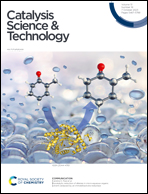Tuning of the electronic, photocatalytic and optical properties of Janus XWAZ2 (X = S, Se, Te; A = Si, Ge; Z = N, P, As) monolayers via strain and external electric field†
Abstract
Owing to their unique structure and properties, two-dimensional Janus materials have garnered significant attention in the field of photocatalytic water decomposition. In this study, we have conducted a comprehensive investigation of the stability, photocatalytic, and optical properties of monolayer 2D Janus XWAZ2 (X = S, Se, Te; A = Si, Ge; Z = N, P, As) using first-principles calculations. Our findings reveal that the inherent dipole of Janus XWAZ2 induces noticeable band bending, resulting in favorable band edge positions and making it an effective photocatalyst. The internal electric field in the structure efficiently separates electrons and holes on different surfaces, effectively suppressing recombination and ensuring high photocatalytic activity. In addition, we explored the modulation of the band gap of the XWAZ2 (X = S, Se, Te; A = Si, Ge; Z = N, P, As) monolayer through biaxial strain and applied an external electric field, further tuning its photocatalytic and optical properties. This study provides valuable insights into the photocatalytic water-splitting of Janus structures and paves the way for future research in this field.



 Please wait while we load your content...
Please wait while we load your content...